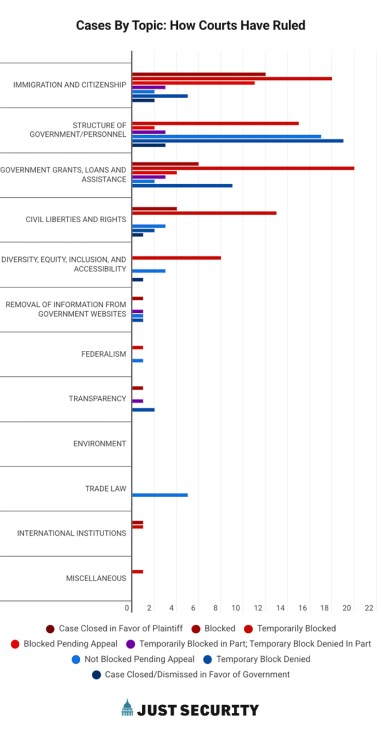Last week we relaunched Just Security’s Litigation Tracker: Legal Challenges to Trump Administration Actions with new features and stats. The infographics below provide a snapshot of what we are seeing, i.e. where litigation stands and how courts are ruling on challenges to the administration’s executive actions.
The Snapshot
The vast majority of challenges to Trump administration executive actions are being met with early court orders (such as preliminary injunctions or temporary restraining orders) that block those actions while judges weigh the legal merits. That trend is particularly pronounced in cases involving immigration and civil liberties, where plaintiffs have scored repeated early wins. But the flipside is true for litigation involving the structure of government and personnel.
Full Overview of All Cases
Interim relief, such as temporary restraining orders, preliminary injunctions, and blocks pending appeal, represents the largest share of case outcomes to date.

How Courts Have Ruled
When courts have ruled, the plaintiffs win about 60 percent of the time (a ratio of 119 wins by plaintiffs versus 79 wins by the government). A large share of cases remain undecided, with many matters still pending before the courts (i.e. awaiting a court ruling).
Case Status Summary
Case Closed in Favor of Plaintiff: 0
Blocked: 44
Temporarily Blocked: 93
Blocked Pending Appeal: 28
Temporarily Blocked in Part; Temporary Block Denied in Part: 12
Temporary Block Denied: 44
Not Blocked Pending Appeal: 39
Awaiting Court Ruling: 257
Case Closed: 27
Misc: Transferred: 2
Case Closed/Dismissed in Favor of Government: 9

Cases by Topic: An Overview
Cases where lawsuits have been filed but the court has not yet issued a ruling dominate across all categories, but especially in cases involving transparency (i.e. FOIA and other related cases).

Case by Topic: How Courts Have Ruled
Where courts have reached a decision, plaintiffs prevail most often in immigration and civil liberties matters; government wins are more common in structural disputes over the structure of government and reductions in force (e.g., termination of government employees). The latter include courts often deciding on jurisdiction, with courts directing plaintiffs to pursue administrative remedies before coming to court.

What to Watch For
Supreme Court Emergency Docket: We are keeping watch on several fast-moving cases, including two emergency stay applications by the administration in the U.S. Supreme Court.
Funding Reinstatement Rulings: We’ve also seen a repeated number of district court judges reinstate funds to universities, states, or non-profit organizations that were either terminated or suspended by the administration.
Data Transparency Restoration: The D.C. Circuit recently issued an order requiring the administration to restore the Public Apportionments Database, a public-facing website that displayed how federal funding is apportioned to agencies.
Removals of Heads of Independent Agencies: Litigation over the president’s authority to remove leaders of independent agencies remains tested across several cases, with mixed lower court rulings and repeated Supreme Court interventions.
Immigration and the First Amendment: Immigration and First Amendment cases also continue to work their way through the courts, with litigation over ICE enforcement practices and conditions inside ICE detention facilities becoming a central legal issue.
Stay Informed with Daily Updates
Every weekday our team identifies new lawsuits challenging executive actions and substantive changes in ongoing cases (such as a new court order). You can find a concise digest of these developments every weekday afternoon in our “Today on Just Security” newsletter.
Engage
Please feel free to let us know if you think we’re missing anything by dropping us an email at lte@justsecurity.org.
If you would like to help support our efforts, we appreciate donations of any amount as it takes a village to produce this work. With many thanks to readers for all the engagement and appreciation we have already received.







